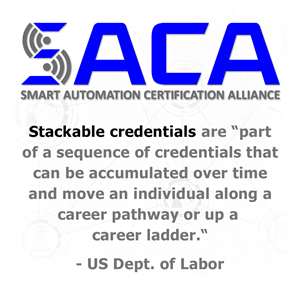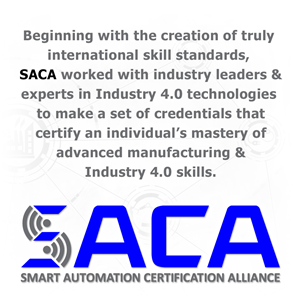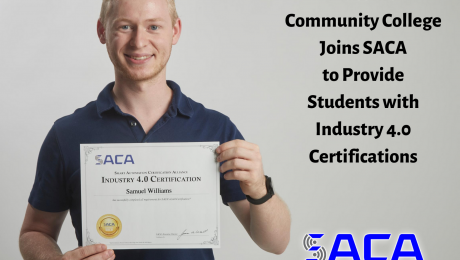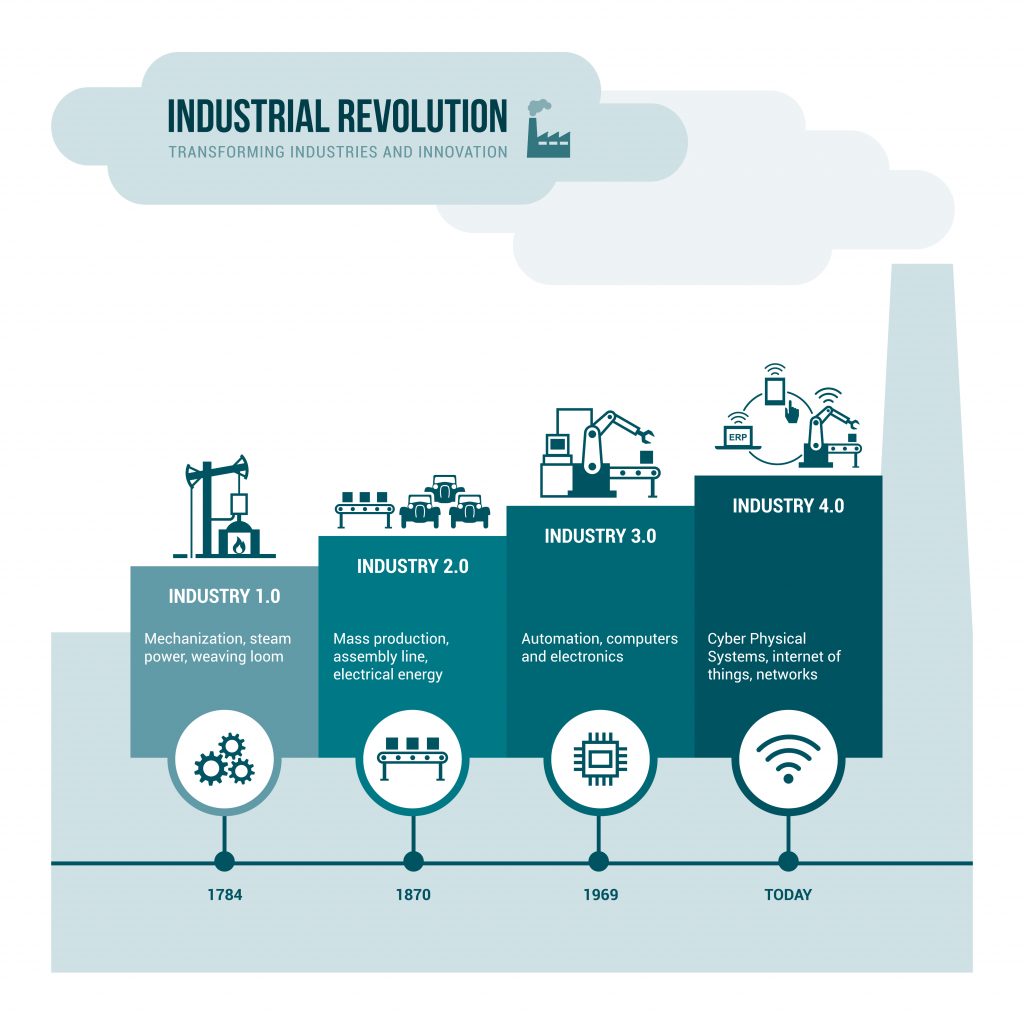Micro-Credentials: The Proof of Knowledge Solution for Industry 4.0
Everyone has taken courses from YouTube University. They encounter car repairs, home projects, or coding errors that they’re unable to fix with their current bank of knowledge, so they search YouTube for videos with intricate explanations and tutorials in order to learn solutions. This act is an informal version of what is referred to as “upskilling” – learning new skills in order to fill a personal knowledge gap in order to accomplish new tasks.
On the other hand, the world is full of people that are well versed in areas that aren’t their profession. Maybe you know an accountant that can repair anything on their car or a math teacher that can install a new electrical outlet in a house.
One thing that these two groups share: no one is going to find them when Google searching “mechanics near me” or “nearby electricians.” When people need a mechanic or an electrician, they want someone with credentials.
Attaining credentials usually involves multi-year degree programs or apprenticeships, which are great for people with no background in a subject. But what’s out there for people that already possess most of the knowledge and skills being taught in those programs? It’s a waste of time and money to send them back to square one because, “that’s how the program works.” And with technological development and adoption speeding up, areas like manufacturing and industry needs something that moves with the speed of change. Enter Micro-Credentials.
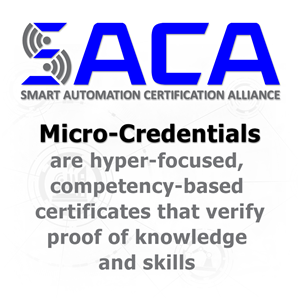
What are Micro-Credentials?
Micro-credentials are hyper-focused, competency-based certificates that verify proof of knowledge and skills. These certificates are meant to supplement degrees and advanced training, not replace them. Basically, micro-credentials do not measure how long you study or how many courses you take; they measure your understanding of a topic and your ability to demonstrate your skill-based competency of the subject. Micro-credentials are also modular, so people can use them to focus on improving skill weaknesses and prove their competency without having to rehash areas that they already know.
What are Stackable Micro-Credentials?
Speaking of modularity, another feature of micro-credentials is that they’re stackable, which is perfect for people in many scenarios. So what’s a stackable credential? As defined by the U.S. Department of Labor, stackable credentials are “part of a sequence of credentials that can be accumulated over time and move an individual along a career pathway or up a career ladder.” So for someone looking to move up the ladder, they can immediately attain credentials for areas where they are already proficient and then continue to add on new credentials as they learn new skills, which will show management a documented interest in continuing education and a commitment to professional growth.
These stackable credentials are also helpful for someone looking to find a new job in the field. They might have years of experience but nothing to verify to a new employer that they are indeed skilled in different areas and disciples. Micro-credentials offer a streamlined way to document someone’s skills without having to start over in a multi-year degree program. Micro-credentials give you immediate credit for things that you already know how to do!
In a third scenario, someone might be downsized from a fading industry and want a fresh start in a new business sector. Micro-credentials provide bite-size documentation of proficiency as this individual builds new skills. If this person wants to enter the manufacturing industry, they could take a handful of foundational courses at a local community college in areas like basic mechanical, basic fluid power, and basic electrical, and then earn corresponding micro-credentials, which would probably be enough to gain an entry-level position. Then the person can continue earning more advanced micro-credentials while they work and learn new skills or take more classes. Eventually, these micro-credentials would stack into an industrial certification that would demonstrate the person’s skill and knowledge to current and future employers across multiple industrial disciplines.
Why are Micro-Credentials Becoming Popular in Manufacturing?
As stated, micro-credentials are important for providing proof of knowledge among any workforce but they are vitally important within the world of manufacturing at the moment because manufacturing is undergoing a new industrial revolution, commonly referred to as Industry 4.0, the Industrial Internet of Things, or Smart Factory. Industry 4.0 takes traditional industrial applications and connects them using wireless internet to produce constant feedback on a variety of metrics including process efficiency, equipment downtime, predictive maintenance tasks, and more!
Employees with years of experience in manufacturing understand the basic technologies, but Industry 4.0 is introducing new technologies and applications that are beyond their scope of knowledge. It doesn’t make sense to start this group over in a bloated training program that begins with basic electrical, mechanical, or fluid power skills. Nor will it make sense for a business to stand still with a workforce that’s not keeping up with new technology as it’s adopted. This is where micro-credentials and SACA can help.
SACA: Certifying the Workforce for Industry 4.0

The Smart Automation Certification Alliance (SACA) is the answer for both education and industry to prove that the manufacturing workforce possesses the necessary skills to be successful in an Industry 4.0 environment. SACA certifications are industry-driven, developed through a rigorous process that begins with truly international skill standards and is endorsed by leading experts in Industry 4.0 technologies throughout the world. SACA’s Smart Automation certifications use a modular structure – including micro-credentials – to enable them to fit a wide range of individual needs, industries, and educational environments. SACA micro-credentials verify that an individual possesses basic industrial skills such as electrical, mechanical, fluid power, rigging, and welding all the way through advanced robot system integration, Industry 4.0 data analytics, and network security.
The world of manufacturing is changing. Gone are the days of dirty, dingy factories. The new shop floor is full of robots, smart components, wireless networks, and Big Data. SACA is the answer to ensuring that the workforce of tomorrow understands these new advances – as well as the basics of industry – and can demonstrate their competency in real-world industrial environments.
- Published in News
SACA: Certifying the Smart Automation Workforce
The evolution of automated technology continues to transform the world’s industrial workplaces in countless ways and there’s no sign of this industrial metamorphosis losing momentum. As Industry 4.0 technology adoption increases, how do companies ensure that potential and current employees have the necessary skills to keep up? Many employers use certifications as a measure of competency, but credentials for Industry 4.0 technology and skills are often tied to specific brands of equipment. But why limit the training spectrum by using a specific brand? How does this make sense when facilities use equipment from multiple brands on their shop floor? What about something more universal, like a certification for job tasks regardless of the equipment used on the manufacturing floor?
The Smart Automation Certification Alliance (SACA), a non-profit organization with the mission to develop and deploy modular Industry 4.0 certifications for a wide range of industries, was founded to aid companies that need employees that are fully versed in cutting-edge Industry 4.0 skills. Working with industry leaders to develop these standards and certifications, SACA built industry-driven credentials with input from companies like FANUC, Rockwell Automation, the Hershey Company, Ashley Furniture Industries, and many others. SACA is also designated as a Standards Recognition Entity (SRE) by the United States Department of Labor.
SACA Certifications: Built for Industry by Industry
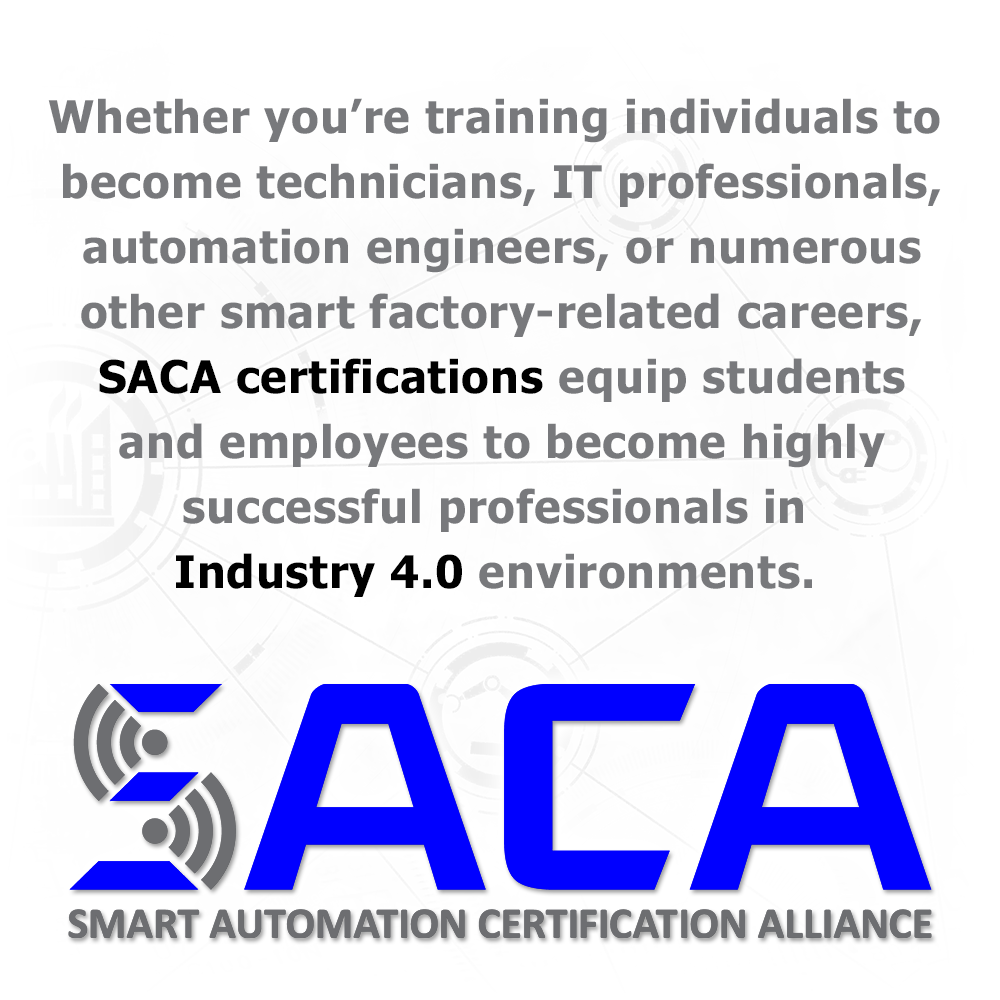
Developing the certifications was a rigorous process. Beginning with the creation of truly international skill standards, SACA worked with industry leaders and experts in Industry 4.0 technologies to make a set of credentials that certify an individual’s mastery of advanced manufacturing and Industry 4.0 job tasks. SACA conducts annual reviews for the certifications ensuring that they remain current as technologies and processes continue to evolve at a rapid pace. By focusing on job tasks and the skills required to perform those tasks, SACA’s certifications give employers assurance when they’re hiring new employees, provide proof of competency for those seeking jobs with companies that have adopted Industry 4.0 technologies, and provide schools and colleges with the confidence that they’re teaching relevant skills.
Who Benefits from SACA Certifications?
Whether you’re training individuals to become technicians, IT professionals, automation engineers, or numerous other smart factory-related careers, SACA certifications equip students and employees to become highly successful professionals in Industry 4.0 environments. SACA offers certifications in three stackable categories: Associate, Specialist, & Professional. These certifications use a modular structure that provides flexibility to fit a wide range of individual needs, industries, and educational environments.
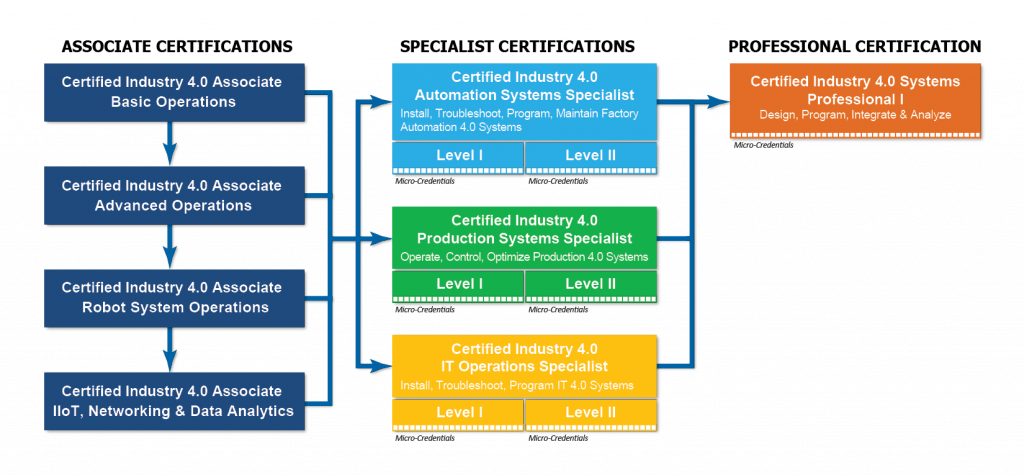
Additionally, the Specialist and Professional-level certifications contain stackable micro-credentials that build upon each other to complete comprehensive certifications. For example, an individual can begin earning micro-credentials for electrical systems, pneumatic systems, robotic operations and many more, which would eventually stack up to SACA’S Certified Industry 4.0 Automation Systems Specialist I credential.
Or companies can use individual micro-credentials to verify that their workforce is up-to-date with the latest technologies and skills to close any skill gaps that already exist. With so many choices in micro-credentials, individuals can quickly transform into versatile team members that can help with a variety of smart factory applications.
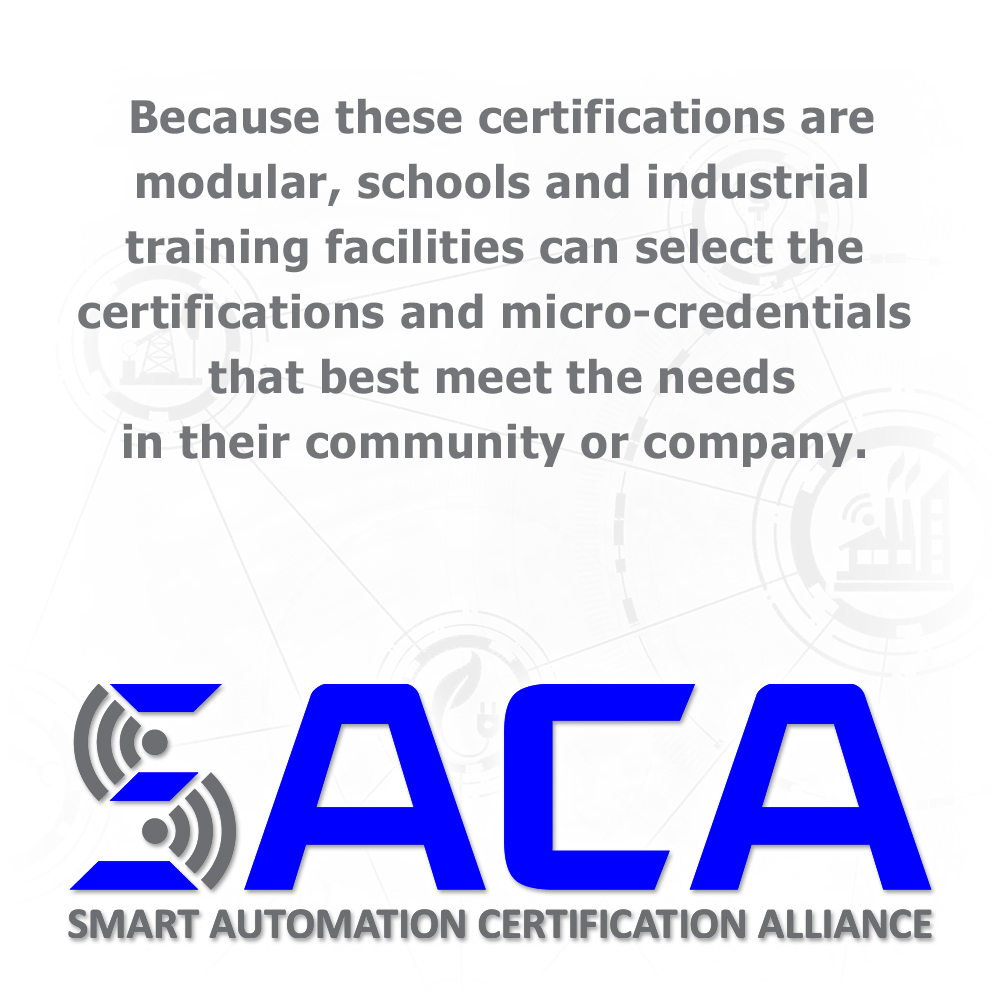
Because these certifications are modular, schools and industrial training facilities can select the certifications and micro-credentials that best meet the needs in their community or company. In many cases, there’s no need to purchase additional training equipment to prepare for the certifications. Many of the skills and micro-credentials from SACA rely on equipment schools or training centers may already have.
How Can Someone Get a SACA Certification?
To attain SACA certifications, individuals must be employees or students of a SACA member institution. Individuals can prepare for the online examination using any text, online courses, or other means that align with the standards. Individuals passing the written examination receive a Silver Credential. Individuals can also demonstrate hands-on competencies on industrial-grade equipment that they’ll see in the workplace. If someone passes both the written and hands-on examinations, they will receive a SACA Gold-level Credential.
SACA certification examinations and hands-on testing are performed at SACA Authorized Testing Centers. Organizations can become a testing center by becoming a SACA member.
How Do I Become a SACA Member? What Are the Benefits of SACA Membership?
SACA offers membership for both educational institutions and industry, so professionals representing those organizations that are interested in membership can reach out to SACA on SACA.org. Educational memberships for high schools and colleges enable these institutions to become authorized certification centers, deliver free certifications to students, and stay informed about the latest developments in Industry 4.0 technology. Companies get all of the aforementioned benefits of educational memberships with additional incentives unlocked by different levels of industry membership. For instance, companies that are Silver Members and above will have a portion of their membership fee designated for named scholarships to sponsor educational institutions and teachers starting new Industry 4.0 certification programs.
Contact SACA Today to Learn More
Industry 4.0 is here and being rapidly adopted by companies around the globe. If students, employees, and companies aren’t preparing and keeping up with this wave of big data, they’ll get swept away by the competition. SACA can help all of the above to adapt and prepare for success. Fill out a contact form to learn how to join SACA, where to find testing sites, and how to get certifications in the hands of your students and employees.
- Published in News
Macomb Community College Joins SACA to Provide Students with Industry 4.0 Certifications
LOUISVILLE, KY—AUGUST 17, 2020
The Smart Automation Certification Alliance (SACA) is pleased to announce that it has recently entered into an agreement with Macomb Community College and ATS Midwest to support the college’s efforts to align its education and training to meet the realities of Industry 4.0. Students completing Macomb’s advanced manufacturing programs will soon earn SACA certifications, giving them a competitive advantage in today’s job market.
Today’s students face a far different world of advanced manufacturing than existed a decade ago. While automation technologies have been commonplace for many years, the Internet has brought about a convergence of new “connected” technologies that is revolutionizing how products are made.
Known as the Fourth Industrial Revolution or Industry 4.0, this latest disruption of the advanced manufacturing world is resulting in reduced downtime and increased quality, productivity, and overall efficiency in industries of all kinds thanks to advanced technologies that make up what is known as the Industrial Internet of Things (IIoT).
IIoT technologies include such things as advanced robotics, machine learning, artificial intelligence, autonomous vehicles and machines, cloud-based data analysis, and cybersecurity. As companies increase their use of networks and Internet technologies, they are connecting more devices, from smart sensors to smartphones.
As a result, these highly-connected systems require new skills in almost every occupation. To succeed in an Industry 4.0 environment, current workers and today’s students must learn to interact with software, data, networks, and smart devices.
While there are many certifications available today that address isolated competencies, from machining to maintenance and information technology (IT), SACA certifications are different. SACA’s Industry 4.0 certifications certify “connected systems” skills that address the integration of the many types of advanced manufacturing technologies with Industry 4.0 technology.
SACA’s Industry 4.0 certifications have been developed for industry by industry through a rigorous process that began with the creation of truly international skill standards. These standards have been endorsed by leading experts in Industry 4.0 technologies around the world.
Working with forward-thinking institutions like Macomb will enable SACA to accomplish its vision to provide highly-affordable, accessible Industry 4.0 certifications that significantly increase the number of individuals who possess the skills represented by these credentials.
The result will be an increasing number of students prepared to be successful in an Industry 4.0 world, as well as more companies that have the highly-skilled workers they need. Don Hutchison, Macomb’s Dean of Engineering and Advanced Technology, agrees:
In southeast Michigan, industry already needs employees who understand how advanced manufacturing systems integrate. At Macomb, we are listening to industry and creating training for individuals and industry that meets the challenges and opportunities of Industry 4.0. Arming Macomb’s graduates with SACA certification signifies to employers that they are prepared to successfully navigate the complex, integrated nature of today’s manufacturing environment.
Fortunately, Macomb also enjoys the support of local industry. Tom Kelly, Executive Director and CEO of Automation Alley, Michigan’s leading manufacturing and technology business association and Industry 4.0 knowledge center, supports Macomb’s vision:
It is encouraging to see Macomb Community College commit to Industry 4.0 training, which will help to ensure industry receives graduates with employable skills. Today, technology is moving at an accelerated pace which requires a new set of working skills. If our state is to keep pace and maintain a global leadership position in manufacturing, we must transform and continuously develop our talent pipeline.
SACA looks forward to a long relationship with Macomb as they, together with industry partner ATS Midwest, begin a thorough review of all of the college’s advanced manufacturing programs to ensure SACA certification requirements are incorporated into the programs’ core curricula. The parties will also be reaching out to local industry to confirm that SACA certification requirements reflect the skills needed by industry. For more information about SACA and how its Industry 4.0 certifications can prepare your students for the jobs of the future, visit SACA.org or contact SACA Executive Director Jim Wall.
- Published in News
SACA Announces Special Membership Rates Due to COVID-19
In an effort to ease some of the burden on school administrators and provide students an opportunity for valuable certifications, the Smart Automation Certification Alliance – a non-profit organization better known as SACA – is offering a special membership price for high schools and colleges to develop and deploy modular Industry 4.0 certifications for a wide range of industries.
From now until Dec. 31, 2020, SACA membership will be available for a special rate to help educational institutes during these difficult times.
- Colleges: A year-long membership for colleges will run $1,750, down from its normal $2,500/year price.
- High Schools: Year-long high school memberships will cost $375, down from its typical $500 annual cost.
Schools will have the option of buying up to three years of membership at this price. Memberships run for 12 months from the time of payment, and this special pricing will not be available in 2021.
Education Member Benefits include:
- Unlimited, free certifications to individuals enrolled as students of the member institution;
- Access to all SACA assessment materials;
- Discounted instructor/administrator training;
- Access to news of latest developments in Industry 4.0 technology, education, and certification;
- Authorization to advertise as a SACA Certification Site;
- Eligible to be profiled by SACA in its communications and advertising;
- Discounted registration fees for SACA Conferences; and
- Eligible to be a member of SACA Education Advisory Panel.
All SACA certifications, which can be attained both in-person and virtually, are available on two levels: Silver and Gold.
SACA Silver Certifications: This certification, which is ideal for distance learning, is awarded to candidates who successfully pass the written knowledge exam. These exams are delivered online through the SACA testing portal. Once the candidate is ready to take the certification test, the proctor logs into the SACA site and clicks the online proctor button. The candidate will then remotely access the certification test.
Silver Certification is ideal for those individuals who are seeking to validate online core achievement or when hands-on testing is not available.
SACA Gold Certifications: This certification is awarded to candidates that successfully pass the written knowledge exam and successfully complete the hands-on performance assessments on approved equipment. Once the skills are demonstrated correctly and reported by the proctor, the candidate is eligible to receive the full Gold certification.
Who Is SACA?
SACA’s vision is to provide highly affordable, accessible certifications that significantly increase the number of individuals who possess the skills represented by these credentials, thereby ensuring that companies have the highly skilled workers they need, and individuals are prepared to be successful in an Industry 4.0 world.
Why Choose SACA?
For schools that choose to become a member of SACA, certification opportunities will be aplenty for students. Not only are SACA certifications industry-driven, and developed for industry by industry, but they are also developed through a rigorous process that begins with the creation of truly international skill standards, endorsed by leading experts in Industry 4.0 technologies throughout the world. Certification examinations are created based on these standards, pilot-tested, and statistically analyzed to ensure quality, and are reviewed annually to ensure standards and examinations remain current and relevant in the fast-changing world of Industry 4.0.
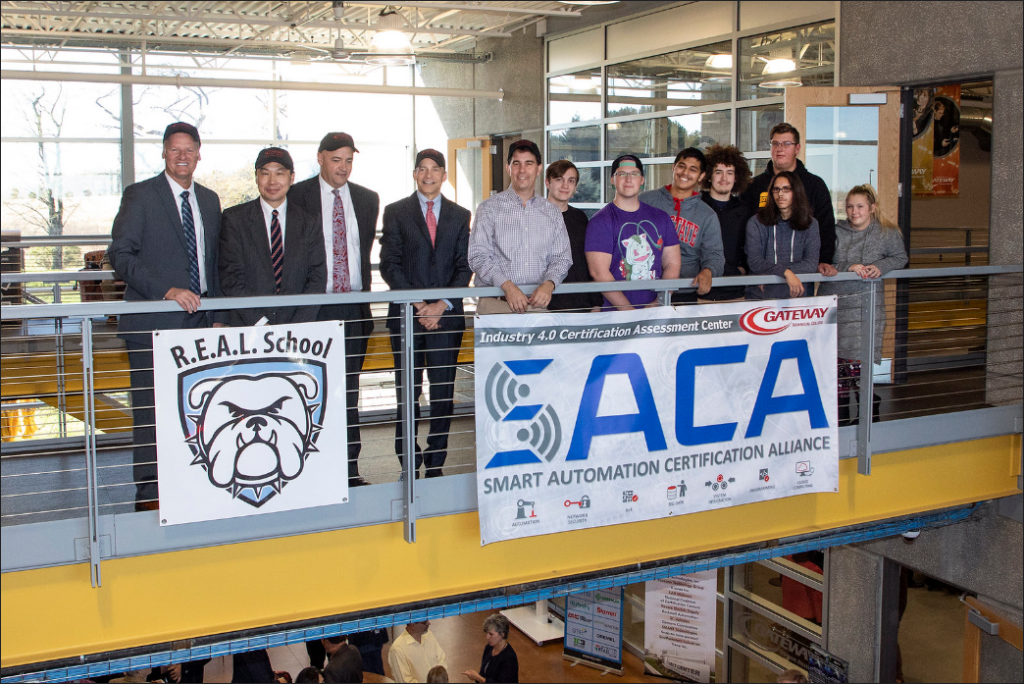
For more information on how to take advantage of SACA’s special membership pricing, please contact us here.
- Published in News
Indiana Governor’s New Initiative Offers Free SACA Silver Certifications for Hoosiers
During Indiana Governor Eric Holcomb’s June 5, 2020 press conference, a new state initiative was announced that will offer 10,000 free credentials to Indiana residents that have been dislocated from their jobs due to the COVID-19 pandemic. The Smart Automation Certification Alliance (SACA) is one of the organizations offering credentials to displaced Hoosier at no cost. SACA’s certifications are task-based and nationally recognized in preparing individuals for rewarding careers working with advanced manufacturing and Industry 4.0 technologies.It’s no secret the immense role that Industry 4.0 is expected to play in the future of industrial manufacturing.
These courses can be taken online and feature virtual simulation of industrial applications, which make them ideal for preparing users for the workplace. The online delivery also allows users to practice social distancing guidelines to help prevent the spread of Coronavirus.
Ivy Tech will coordinate enrollment of new students while Amatrol and Aidex will help to promote this opportunity to displaced Indiana residents seeking a new career path. Amatrol will also provide free access to its Learning Management System (LMS) for students enrolled in this program.
When a student completes one of the six courses, they will be eligible to sit for the associated SACA Silver Credential. SACA Silver Credentials are completed solely online while Gold Credentials involve hands-on skill demonstrations. Students are eligible to earn all six SACA Silver credentials.
People interested in these opportunities can visit YourNextStepIN.org, which is part of Indiana’s Rapid Recovery for a Better Future initiative. Lubbers said, ““Visitors to the site can talk to a real person to answer questions and help them determine the right path forward and the training options that will help them achieve their goals. These partners and tools help to connect Hoosiers to opportunities — some that already exist — and we will continue to build on these connectors in the weeks and months ahead.”
The free courses and associated SACA Credentials are as follows:
Production Operations Technician
- Certified Industry 4.0 Associate I (C-101): Students will study Industry 4.0 concepts, safety, quality, technical drawings, machine operation and maintenance, and hand tools.
- Certified Industry 4.0 Associate II (C-102): Students will study manufacturing systems performance, mechanical and fluid power systems, programmable controller systems, CNC and additive manufacturing, system communications, and mechatronics.
Multi-Skill Maintenance Technician
- Electrical Systems 1 (C-201): Students will study electrical system safety, electrical schematics and diagram, taking electrical measurements using a digital mustimeter (DMM), combination circuits, electrical circuit troubleshooting, and inductive and capacitive circuit analysis.
- Electric Motor Control Systems 1 (C-202): Students will study electric motor safety, ladder logic schematics, how to properly ground connections, transformer selection and installation, how to connect and operate a 3-phase motor, and how to connect and operate a variety of electric motor circuits including manual motor, 2/3 wire magnetic motor starter, reversing motor control, hands-off-auto motor control, and basic timer control.
- Motor Control Troubleshooting 1 (C-204): Students will study how to troubleshoot motor control components, use a clamp-on ammeter to measure motor current, and troubleshoot a variety of motor control circuits and an AC VFD motor control system.
- Pneumatic Systems 1 (C-209): Students will study pneumatic system safety procedures, pneumatic schematics interpretation, how to connect and adjust pneumatic supply lines, how to start up and shut down a reciprocating air compressor, how to connect and operate basic pneumatic circuits, how to monitor system operation, pressure and force, and how to perform basic system servicing.
- Published in News

The Importance of a Smart Automation Certification
- Published in News
Smartphones, Smartwatches, & Now Smart…Factories?
Did you ever have math teachers who were real sticklers for knowing the fundamentals? Frequent reminders to “show your work” were likely accompanied by the admonition that “you’re not always going to have a calculator in your pocket!”
Well, I guess we showed them didn’t we? The smartphones that occupy our pockets today not only have a calculator, a telephone, a calendar, a map, an address book, a clock, a camera, and a music player, they also contain a nearly-limitless variety of applications that give us access to data and capabilities unimaginable a generation ago.
Your smartphone might connect to a smartwatch that keeps track of your heart rate while you read emails on the go. It might also connect to a variety of smart home devices, allowing you to turn on light bulbs, answer the doorbell, and lower the thermostat from anywhere in the world.
The Internet of Things (IoT)

All of these so-called “smart” devices are part of what’s now known as the “Internet of Things” (IoT). The IoT allows a wide variety of devices to connect and communicate using the Internet, making life more convenient in ways many people never dreamed possible.
There are now even voice-activated assistants ready to do our bidding. Today, a call of “Hey Siri!” or “Hey Alexa!” might be followed by a command to turn on the outside lights at home, an inquiry about the state capital of Wisconsin (it’s Madison, by the way), a request for the latest weather forecast, or an appeal for a quick eggs Benedict recipe.
Our lives have been forever transformed by the IoT. Today’s youth have grown up in a world of connected devices. Even older adults, though, now use these devices and understand their benefits. Many of us see how they make our day-to-day lives easier, but do we fully realize how they will impact our jobs, both now and into the future?
The Fourth Industrial Revolution
History buffs will remember that the Industrial Revolution began in the second half of the 18th century when manpower began to be replaced by machines powered by steam or coal. What many people don’t realize, however, is that scholars have identified subsequent revolutions in industry.
The Second Industrial Revolution got its start in the first half of the 19th century when electricity combined with the assembly line to allow mass production. A Third Industrial Revolution traces its roots to the 1950s when the digital age was born with the advent of the first computers and the beginnings of automation.
Today, we find ourselves in the early stages of the Fourth Industrial Revolution when cyber-physical systems, automation, and the IoT will combine to create a Smart Factory environment that holds the potential for a massive impact on industrial efficiency and productivity.
Whatchamacallit
This new Fourth Industrial Revolution goes by a variety of names and terms: Smart Automation, Smart Factory, Smart Manufacturing, the Industrial Internet of Things (IIoT), the Industrial Internet, the Connected Enterprise, and Industry 4.0, to name a few. Whatever you choose to call it, it’s both the wave of the future and the present reality.

Smart factories already exist, and they’re getting bigger and better every day. Industry 4.0 pioneers in a wide variety of industries are forcing competitors to embrace Smart Automation as a tool to take them to the next level.
Inside the Smart Factory
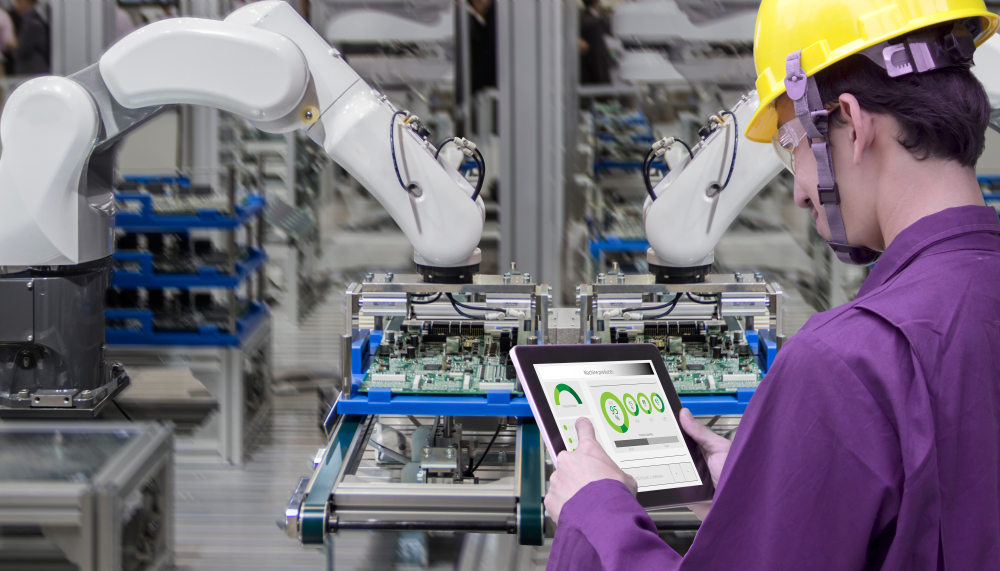
What is a Smart Factory like? Envision a facility in which self-driving vehicles communicate with production-line robots to request and deliver necessary parts without human intervention. Imagine these connected machines on the production floor communicating with workers on the top floor to convey a wide variety of information, such as production cycle times, mechanical breakdowns, and predictive maintenance.
Smart robots and machines equipped with smart sensors can generate a virtually-unlimited amount of data (often referred to as “big data”) that can be shared with multiple locations via cloud technology. This data can be used not only to monitor real-time production status but also to predict future maintenance needs. Can you imagine a robot continually analyzing its productivity and condition, so it can order replacement parts or other maintenance needs before it breaks down?
The Skills Gap

At one time, many workers feared the day when robots would replace humans in the workplace. Some still do. However, the reality of Industry 4.0 is quite different. While it’s true that robots and automated machines have replaced some jobs, the advanced technologies required by Industry 4.0 have and will continue to generate a tremendous demand for highly-skilled workers to program, analyze, and maintain the many parts of these complex systems.
That sounds fantastic until you realize that industry experts believe there’s a tremendous shortage of workers qualified to fill these positions. According to a recent study by Deloitte, nearly 3.5 million manufacturing jobs will need to be filled in the next decade. Because of what is commonly known as the “skills gap,” however, experts estimate as many as 2 million of those jobs could go unfilled.
Training for a New World

Despite the fact that we live in a connected world and understand its benefits, many people still lack the skills they will need to thrive in an Industry 4.0 environment. While many people have embraced advanced technology in their personal lives, they lack real-world exposure to manufacturing equipment and processes.
To prepare students and current workers for careers in smart factories, educators and companies must teach skills in a variety of areas, including industrial equipment and technology, smart sensors and smart devices, computerized control systems, network security, and data collection and analysis. Experience with real-world equipment and access to state-of-the-art training will be critical.
SACA’s Vision
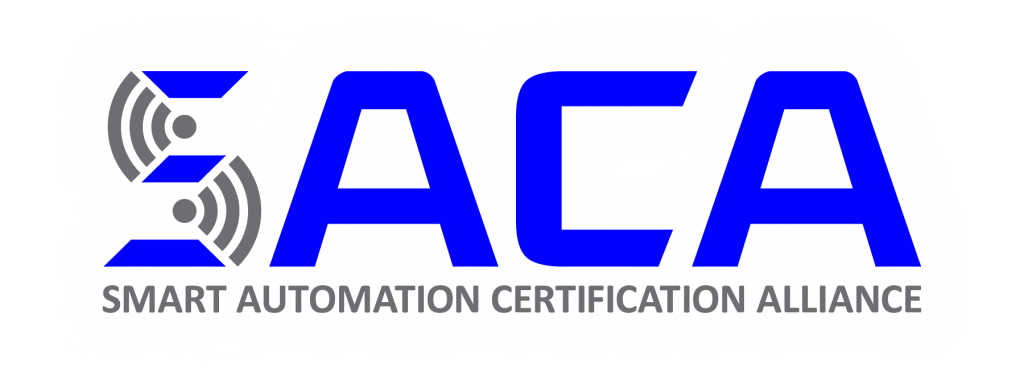
Once you gain experience and receive the training you need, how will you market yourself to employers? How can you easily demonstrate to others the skills, experience, and training that you possess?
The Smart Automation Certification Alliance (SACA) offers highly-affordable, accessible Industry 4.0 certifications for a wide range of industries. While many certifications are available today that address isolated competencies, from welding and machining to maintenance and IT, SACA certifications are different. They certify “connected systems” skills that address the integration of these technologies with Industry 4.0 technology.
SACA’s vision is to provide certifications that significantly increase the number of individuals who possess the skills represented by these credentials. This will ensure that companies have the highly-skilled workers they need, and individuals are prepared to be successful in Smart Factory jobs that require certified “connected systems” skills.
- Published in News


